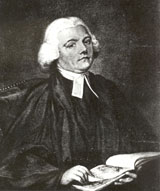- Gilbert White
:"This article is about the 18th-century English naturalist. For the 20th-century American geographer, see
Gilbert F. White . Neither should be confused with Gilbert White (1859–1932), Bishop of Carpentaria, Australia, who was also a poet, or with Gilbert White (1877–1939), the American painter."Infobox Scientist
name = PAGENAME
box_width =
image_width =150px
caption =This 'portrait' is not now generally accepted as authentic.
birth_date =18 July 1720
birth_place =Selborne ,Hampshire
death_date =26 June 1793
death_place =
residence =
citizenship =
nationality =United Kingdom
ethnicity =
field = naturalist ornithologist
work_institutions =
alma_mater =
doctoral_advisor =
doctoral_students =
known_for =
author_abbrev_bot =
author_abbrev_zoo =
influences =
influenced =
prizes =
religion =
footnotes =Gilbert White (
18 July 1720 –26 June 1793 ) was a pioneering naturalist and ornithologist.White was born in his grandfather's vicarage at
Selborne inHampshire . He was educated by a private tutor inBasingstoke before going toOriel College, Oxford . He obtained hisdeacon 's orders in 1746, being fully ordained in 1749, and subsequently held several curacies in Hampshire andWiltshire , including Selborne's neighbouring parishes ofNewton Valence andFarringdon , as well as Selborne itself on four separate occasions. In 1752/53 White held the office of JuniorProctor at Oxford and was Dean of Oriel. In 1757 he became non-residentperpetual curate ofMoreton Pinkney inNorthamptonshire . After the death of his father in 1758, White moved back into the family home at "The Wakes" in Selborne, which he eventually inherited in 1763. In 1784 he became curate of Selborne for the fourth time, remaining so until his death. Having studied at Oriel at the behest of his uncle, he was ineligible to be considered for the permanent living of Selborne, which was in the gift of Magdalen College.White is best known for his "
The Natural History and Antiquities of Selborne " (1789). This was a compilation of his letters toThomas Pennant , the leading Britishzoologist of the day, and the Hon.Daines Barrington , an Englishbarrister and another Fellow of theRoyal Society . These letters contained White's discoveries about local birds, animals and plants. He believed in distinguishing birds by observation rather than by collecting specimens, and was thus one of the first people to separate the similar-lookingChiffchaff ,Willow Warbler andWood Warbler by means of their song.White is regarded by many as
England 's firstecologist and one of the founders of modern respect for nature. [Hazell, D.L., Heinsohn, R.G. and Lindenmayer, D.B. 2005. Ecology. Pp. 97-112 in R.Q. Grafton, L. Robin and R.J. Wasson (eds.), "Understanding the Environment: Bridging the Disciplinary Divides". Sydney, NSW: University of New South Wales Press, (p. 99).] He said of theearthworm (1770):Earthworms, though in appearance a small and despicable link in the chain of nature, yet, if lost, would make a lamentable chasm [...] worms seem to be the great promoters of vegetation, which would proceed but lamely without them...
White and William Markwick collected records of the dates of emergence of more than 400 plant and animal species, White recording in Hampshire and Markwick in
Sussex between 1768 and 1793. These data, summarised in "The Natural History and Antiquities of Selborne" as the earliest and latest dates for each event over the 25-year period, are among the earliest examples of modernphenology . His 1783/4 diary corroborates the dramatic climatic impacts of the volcanic 'Laki haze' that spread from Iceland with lethal consequences across Europe.White's frequent accounts of a
tortoise inherited from his aunt in "The Natural History and Antiquities of Selborne" form the basis forVerlyn Klinkenborg 's book, "Timothy; or, Notes of an Abject Reptile" (2006), as well as forSylvia Townsend Warner 's "The Portrait of a Tortoise" (1946).His house in Selborne, "The Wakes", now contains the Gilbert White Museum, as well as the Oates Memorial Museum, commemorating Frank and
Lawrence Oates .A biography of White, by
Richard Mabey was published byCentury Hutchinson in 1986, and won the Whitbread Biography of the Year award.A documentary about White, presented by historian Michael Wood, was broadcast by
BBC Four in 2006.Gilbert White's famous work has been continuously in print since its first publication and is one of the most frequently published books in the English language. The paperback edition of "The Illustrated Natural History of Selborne" was last reprinted by
Thames & Hudson in 2007.Notes
Further reading
*Worster, D. 1994. "Nature's Economy: A History of Ecological Ideas" (2nd ed.). Cambridge; New York, NY, USA: Cambridge University Press.External links
* [http://www.gilbertwhiteshouse.org.uk/ Gilbert White's House and the Oates Museum]
* [http://onlinebooks.library.upenn.edu/webbin/gutbook/author?name=White%2c%20Gilbert Project Gutenberg edition of The Natural History of Selborne]
*
* [http://www.wardsbookofdays.com/26june.htm Gilbert White's life @ "Ward's Book of Days"]
Wikimedia Foundation. 2010.
